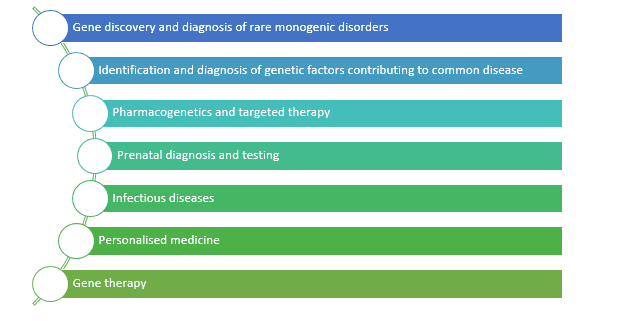Unlocking the Genetic Code: Exploring the Frontiers of Genomics
Overview
Genomics is an interdisciplinary field of biology focusing on the structure, function, evolution, mapping, and editing of genomes. A genome is an organism’s complete set of DNA, including all of its genes as well as its hierarchical, three-dimensional structural configuration. In contrast to genetics, which refers to the study of individual genes and their roles in inheritance, genomics aims at the collective characterization and quantification of all of an organism’s genes, their interrelations, and their influence on the organism.
Genes may direct the production of proteins with the assistance of enzymes and messenger molecules. In turn, proteins make up body structures such as organs and tissues as well as control chemical reactions and carry signals between cells.
Genomics also involves the sequencing and analysis of genomes through the use of high-throughput DNA sequencing and bioinformatics to assemble and analyze the function and structure of entire genomes.
Genomics v/s Genetics
Genomics is distinct from genetics. While genetics is the study of heredity, genomics is defined as the study of genes and their functions, and related techniques.
The main difference between genomics and genetics is that genetics scrutinizes the functioning and composition of a single gene whereas genomics addresses all genes, and they are interrelationships to identify their combined influence on the growth and development of the organism.
The father of genomics: Frederick Sanger (1918–2013)
Frederick Sanger, ‘the father of genomics’, was one of just four scientists to win two Nobel prizes and the only one to receive both in chemistry. Both were awarded for the invention of methods to determine the order of the biological building blocks of life.
Applications of Genomics

Genomics: Market size
The global Genomics market size is expected to be worth around US$ 96.25 billion by 2030. The global Genomics market size was valued at US$ 27.90 billion in 2021 and is anticipated to grow at a CAGR of 20.9% during the forecast period from 2022 to 2030.
The market has witnessed multiple product launches in 2020 owing to a rise in competition for the development of genomic testing solutions for COVID-19. For instance, in December 2020, ThermoFisher launched Applied Biosystems TaqCheck SARS-CoV-2 Fast PCR Assay—a new saliva-based PCR test for the detection of COVID-19 infection. Similarly, in June 2020, Cepheid announced the development of the Xpert Xpress SARS-CoV-2/Flu/RSV four-in-one test, which can detect these four pathogens from a single sample. This test can be run on Cepheid’s GeneXpert Systems.
Genomics: Driving factors
- Rising Number of Government-aided Genome Projects to Aid Growth: One of the prominent factors that have contributed to the growth of the market is the increasing number of government-funded genome projects. A genomic study is an essential tool that can aid the development of effective therapies; a primary factor why several government organizations are investing in genome projects. For instance, Genomics England collaborated with the NHS and started the Genomic Medicine Service, which incorporated whole genome sequencing into routine medical care
- New Products and Innovative Services to Favor Adoption of Genomic Sequencing: The shift towards personalized medicines and decreasing costs of sequencing owing to the introduction of NGS technology, have yielded several new products and services. The market is gradually becoming more competitive with new players entering the market, and hence the companies are introducing advanced products and services to consolidate their position
Types of genomics

People are studying and experimenting with genomics for many different purposes. Here are examples of the different types of genomics:
- Structural genomics: Aims to determine the structure of every protein encoded by the genome
- Functional genomics: Aims to collect and use data from sequencing for describing gene and protein functions
- Comparative genomics: Aims to compare genomic features between different species
- Mutation genomics: Studies the genome in terms of mutations that occur in a person’s DNA or genome
Conclusion
In conclusion, Genetics, which refers to the study of individual genes and their roles in inheritance, genomics aims at the collective characterization and quantification of all of an organism’s genes, their interrelations, and their influence on the organism. The main difference between genomics and genetics is that genetics scrutinizes the functioning and composition of a single gene whereas genomics addresses all genes, and they are interrelationships in order to identify their combined influence on the growth and development of the organism. The market has witnessed multiple product launches in 2020 owing to a rise in competition for the development of genomic testing solutions for COVID-19.
Author: Dipanshi Singh
